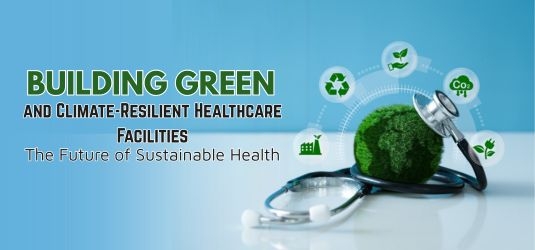
As the world grapples with climate change and environmental degradation, healthcare facilities stand at a critical crossroads. Not only are they the first responders during climate-induced emergencies, but they are also significant contributors to greenhouse gas emissions and resource consumption. Embracing green and climate-resilient healthcare is no longer optional—it is essential for the health of both people and the planet.
What Is a Green and Climate-Resilient Healthcare Facility?
A green and climate-resilient healthcare facility is designed and operated to anticipate, respond to, and recover from climate-related shocks while minimizing its environmental footprint. These facilities focus on energy efficiency, water conservation, sustainable procurement, and waste reduction, all while ensuring high-quality patient care.
Key Components of Sustainable Healthcare Facilities
Energy Efficiency: Upgrading to LED lighting, installing solar panels, and conducting regular energy audits help reduce operational costs and lower greenhouse gas emissions. These measures not only cut utility bills but also make facilities less vulnerable to power disruptions during extreme weather events.
Water Conservation: Implementing rainwater harvesting, using low-flow fixtures, and recycling water through advanced treatment systems ensure reliable water supply, especially during periods of scarcity.
Smart Building Design: Thoughtful architectural planning reduces unnecessary movement, enhances fire safety, and creates patient-friendly spaces that prioritize privacy, comfort, and security. Green building materials and landscaping further reduce the environmental impact.
Waste Management: Proper segregation, reduction, and recycling of waste, along with the safe handling of hazardous materials, are crucial for minimizing pollution and protecting public health.
Sustainable Procurement: Choosing products and services with lower environmental impacts—such as energy-efficient equipment and eco-friendly cleaning supplies—supports the facility’s sustainability goals while often reducing long-term costs.
Staff Training and Community Engagement: Regular training ensures that all staff understand and implement green practices. Involving the community through awareness programs amplifies the impact, fostering a culture of sustainability.
Why Invest in Green Healthcare?
Resilience to Climate Change: Facilities that are energy- and water-efficient can continue operating during extreme weather, ensuring uninterrupted patient care.
Cost Savings: Sustainable practices reduce resource consumption, leading to significant savings on energy and water bills.
Healthier Environments: Reducing emissions and pollution creates a safer environment for patients, staff, and the surrounding community.
Contribution to National and Global Goals: Green healthcare supports India’s climate commitments and the United Nations Sustainable Development Goals, aligning with broader efforts to combat climate change.
Final Thoughts
Transforming healthcare facilities into green and climate-resilient spaces is a journey that requires commitment, innovation, and collaboration. By adopting sustainable practices, healthcare leaders can ensure their institutions are prepared for the future—delivering quality care while safeguarding environmental and public health for generations to come.








